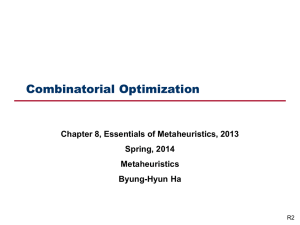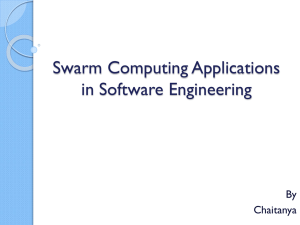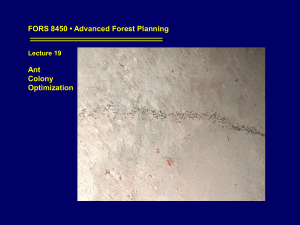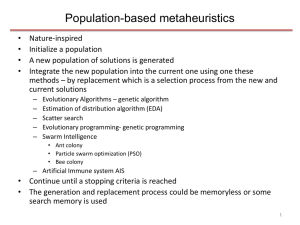Selecting Optimized Test Case Set Using Hybrid Intelligence
advertisement
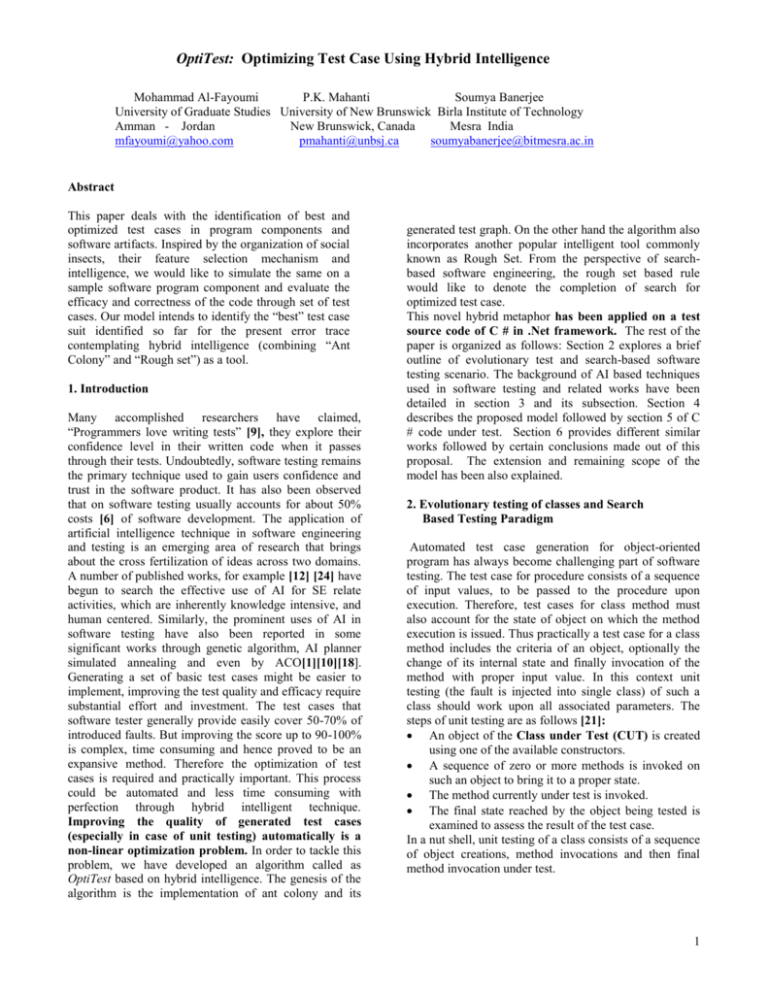
OptiTest: Optimizing Test Case Using Hybrid Intelligence
internal pheromone distribution across the generated test
Mohammad Al-Fayoumi
P.K. Mahanti
Banerjee
graph. OnSoumya
the other
hand the algorithm also incorporates
University of Graduate Studies University of New Brunswick
Birla
Institute
of Technology
another
popular
intelligent
tool commonly known as
Amman - Jordan
New Brunswick, Canada
Mesra
Rough Set.
FromIndia
the perspective of search-based software
mfayoumi@yahoo.com
pmahanti@unbsj.ca engineering,
soumyabanerjee@bitmesra.ac.in
the rough set based rule would like to denote
the completion of search for optimized test case. This
novel hybrid metaphor has been
Abstract
This paper deals with the identification of best and
optimized test cases in program components and
software artifacts. Inspired by the organization of social
insects, their feature selection mechanism and
intelligence, we would like to simulate the same on a
sample software program component and evaluate the
efficacy and correctness of the code through set of test
cases. Our model intends to identify the “best” test case
suit identified so far for the present error trace
contemplating hybrid intelligence (combining “Ant
Colony” and “Rough set”) as a tool.
1. Introduction
Many accomplished researchers have claimed,
“Programmers love writing tests” [9], they explore their
confidence level in their written code when it passes
through their tests. Undoubtedly, software testing remains
the primary technique used to gain users confidence and
trust in the software product. It has also been observed
that on software testing usually accounts for about 50%
costs [6] of software development. The application of
artificial intelligence technique in software engineering
and testing is an emerging area of research that brings
about the cross fertilization of ideas across two domains.
A number of published works, for example [12] [24] have
begun to search the effective use of AI for SE relate
activities, which are inherently knowledge intensive, and
human centered. Similarly, the prominent uses of AI in
software testing have also been reported in some
significant works through genetic algorithm, AI planner
simulated annealing and even by ACO[1][10][18].
Generating a set of basic test cases might be easier to
implement, improving the test quality and efficacy require
substantial effort and investment. The test cases that
software tester generally provide easily cover 50-70% of
introduced faults. But improving the score up to 90-100%
is complex, time consuming and hence proved to be an
expansive method. Therefore the optimization of test
cases is required and practically important. This process
could be automated and less time consuming with
perfection through hybrid intelligent technique.
Improving the quality of generated test cases
(especially in case of unit testing) automatically is a
non-linear optimization problem. In order to tackle this
problem, we have developed an algorithm called as
OptiTest based on hybrid intelligence. The genesis of the
algorithm is the implementation of ant colony and its
generated test graph. On the other hand the algorithm also
incorporates another popular intelligent tool commonly
known as Rough Set. From the perspective of searchbased software engineering, the rough set based rule
would like to denote the completion of search for
optimized test case.
This novel hybrid metaphor has been applied on a test
source code of C # in .Net framework. The rest of the
paper is organized as follows: Section 2 explores a brief
outline of evolutionary test and search-based software
testing scenario. The background of AI based techniques
used in software testing and related works have been
detailed in section 3 and its subsection. Section 4
describes the proposed model followed by section 5 of C
# code under test. Section 6 provides different similar
works followed by certain conclusions made out of this
proposal. The extension and remaining scope of the
model has been also explained.
2. Evolutionary testing of classes and Search
Based Testing Paradigm
Automated test case generation for object-oriented
program has always become challenging part of software
testing. The test case for procedure consists of a sequence
of input values, to be passed to the procedure upon
execution. Therefore, test cases for class method must
also account for the state of object on which the method
execution is issued. Thus practically a test case for a class
method includes the criteria of an object, optionally the
change of its internal state and finally invocation of the
method with proper input value. In this context unit
testing (the fault is injected into single class) of such a
class should work upon all associated parameters. The
steps of unit testing are as follows [21]:
An object of the Class under Test (CUT) is created
using one of the available constructors.
A sequence of zero or more methods is invoked on
such an object to bring it to a proper state.
The method currently under test is invoked.
The final state reached by the object being tested is
examined to assess the result of the test case.
In a nut shell, unit testing of a class consists of a sequence
of object creations, method invocations and then final
method invocation under test.
1
For example, if we are testing method m of class A, a test
case may be:
A a = new A ( );
B b = new B ( );
b.f(2);
a.m(5, b);
Here, the second object creation is necessary, because the
second parameter of m is an object of class B. Invocation
of f on b aims at changing the state of b before passing it
to m. In this context of this proposal we would also like to
brief about the search based test data generation
technique, which also largely influence this
implementation. The search based test data generation
requires some basic concepts as prerequisites, which starts
from control flow graph [18]. A control flow graph (CFG)
of a program is a directed graph G = (N, E, s, e) where N
is a set of nodes, E is a set of edges, and s and e are
unique entry and exit nodes to the graph. Each node n
N corresponds to a statement in the program, with each
edge e = (ni, nj)
E representing a transfer of control
from node ni to nj. Nodes corresponding to decision
statements (for example an if or while statement) are
referred to as branching node. In the Figure 1 nodes 1, 2,
and 3 are all branching nodes. Outgoing edges from these
nodes are referred to as branches. The branch executed
when the condition at the branching node is true is
referred to as the true branch. Conversely, the branch
executed when the condition is false is referred to as the
false branch. The predicate determining whether a branch
is taken is referred to as a branch predicate. The branch
predicate of the true branch from branching Node 1 in the
program of Figure 1 is ‘a >= b’.
CFG Node
(s) void example (int a, int b, int c, int d)
{
(1) if (a >= b)
{
(2) if (b <= c)
{
(3) if (c == d)
{
// T.....
Figure 1: Code Segment for CFG
The comprehensive suit of unit testing is well supported
successfully by Evolutionary algorithms for procedural
software ([19, 7], referred to as conventional evolutionary
testing). Even the application of metaheuristic search
techniques to test data generation is a possibility, which
offers much promise for these different types of software
testing problems. Metaheuristic search techniques are
high-level frameworks, which utilize heuristics in order to
find solutions to combinatorial problems at a reasonable
computational cost. Such a problem may have been
classified as NP-complete or NP-hard, or be a problem
for which a polynomial time algorithm is known to exist.
3. Software Testing and AI
The application of artificial intelligence methodologies
in software testing have been reported in several
accomplished works. The varieties of AI based tools are
applied for test data generation, search, optimization and
coverage analysis and test management .Most commonly
applied tool is genetic programming [20] [24] .
Very recently couples of noted works of Baudry et al.
exhibit a new dimension of testing through their simulated
bacteriological adoption algorithm [3] [4] [5].
which significantly contributed to formulate certain basic
framework for this type of testing paradigm by proposing
different object specific mutation operators dedicated to
Java language [21] [8]. The concept of interface testing
and validation has already been used to test EJB
components [2]. All these works actually map the
problem for test data generation to the problem of
minimization and study Genetic Algorithm to tackle this
minimization problem.
They also tested their schemes to .Net components [4]. In
practical testing scenario, it’s difficult to generate test
data manually, as it makes the code more and more error
prone. Therefore automated test data generation [16] has
become authentic approach for software testing. The
various forms of this technique have been found in the
local search [19] [20] (for searching structural test data
generation) with simulated annealing [15] [21] and other
evolutionary algorithms. The major difference between all
these work and the proposal presented in this paper is that
they are concerned in generating the scalar data, whereas
method calling and argument passing in the intermediate
control flow dependency graph is the basis of this paper.
The other specialty of the proposal is to create a novel
hybrid framework inspired by natural agent ant, which
lives in a colony and on the other hand rough set theory,
which work under uncertainty and in imprecise
conditions. The distributed coordination mechanism of
ant agents through a chemical marker called as
pheromone also able to notify and mark best or good path
of choice. This path is shortest by default. Rough Set
Theory offers the heuristic function to measure the quality
of a single subset of test case. Rough set is also used to
stop the searching process of test cases if best or
optimized test case is found. The next subsection will
present some basics on these two methodologies to
understand the proposed algorithm OptiTest.
3.1 Background of Ant colony and
Rough Set Theory
Ant Colony Optimization (ACO) [13] [14] is a recently
proposed meta-heuristic approach for solving hard
combinatorial optimization problems. The inspiring
2
source of ACO is the pheromone trail laying and
following behavior of real ants, which use pheromones as
a communication medium. In analogy to the biological
example, ACO is based on the indirect communication of
a colony of simple agents, called (artificial) ants,
mediated by (artificial) pheromone trails. The pheromone
trails in ACO serve as distributed, numerical information,
which the ants use to probabilistically construct solutions
to the problem being solved, and which the ants adapt
during the algorithm’s execution to reflect their search
experience. Rough set theory [26] is an extension of
conventional set theory that supports approximations in
decision-making. The rough set itself is the approximation
of a vague concept (set) by a pair of precise concepts.
Here the quality of test case is measured and the process
for searching “best” quality test case is stopped by rough
set constructs.
4. Proposed Model –Optitest
The proposed algorithm envisages the modeling of the
unit test mentioned in the previous section (refer section
2) for object oriented source code. The algorithm takes as
input initial set of test cases and it outputs a “good” or
“optimized” set of test cases. The process goes on
incrementally as test pheromone corresponds to a test
case. We consider a C# parser, the input data here is a
source file that is parsed to build a syntactic tree.
Subsequently, the source code is interpreted in term of
CFG, which is a directed graph. There are several issues
need to be addressed prior to deploy ACO:
Interpretation
of
testing
problem
with
decomposable graph.
A heuristic measure for measuring the “goodness”
of path through the graph.
A rough set based rule for stopping the search.
A transition rule for determining the probability of
an ant traversing from one node in the graph to the next.
Update matrix for pheromone deposition by ant
colony on a particular edge of test graph.
High-level description of proposed algorithm --OptiTest
Begin Algorithm GenerateTestCases (Class Under Test CUT: Class)
/* Generate Test Case*/
Input: CUT
Output: Deterministic Best Test Case
/*Initialize Parameters for Ant Colony and Rough set
Paradigm*/
Set t: = 0
/* t is the time counter */
Set NC: = 0
/* NC is the cycle counter*/
for every edge (i, j) set an initial value τ ij = C for trail
intensity and Δ τ ij = 0
Bool TestPheromoneValue= FALSE;
Tabu = Empty;
Place the m ants on the n nodes
P, Q equivalent Relations over Test case
/ * Stopping Criteria of search defined by Rough set */
Testgoals:= the set of coverage goals
Failures: = empty set
Identify test cluster for CUT
/*Initialize Parameters for generating Test case*/
Device Source code for Test Cluster
/*Example Test: for C# Code to be parsed to .Net
platform*/
Accumulate test Goals for CUT
Generate function set for Test Cluster
for each test goal tg in TG
/* Loop for generating normal test goals*/
modify function test for TG
end for
Create initial di- graph based test cases
for cycle =1 to ncycles do
for ant =1 to n ants do
Select the vertex with the lowest
pheromone level from the
current vertex
If vertices vi and vj shares the same lowest pheromone
level but if TG (Vi) = =0 and TG (Vj) =1
Select vi
else
Select randomly any vertex
end if
ant clears its recentlyvisited tabu list
/* no test Goal in Tabu*/
UpdatePheromone (τ, ρ)
/*Pheromone Update Rule*/
update pheromone trails by applying the rule
τ ij (t) → (1- ρ). τ ij (t) + ∆ τ ij (t) where
1 / c ( )
∆ τ ij (t) =
otherwise
0
end for
Set TestPheromoneValue = TRUE;
p
(r, u) *
(r, u)
k
(r, u)
* (r, u)
According to ant movement rule:
/*
(r, u) is the intensity of pheromone on the edge
between the node position r and u,
and
represents
a weight for the pheromone and weight for the heuristic of
(r , u ) */
3
while Testgoals is nonempty do
Select and remove goal from goals
Call PheromoneUpdate( ) to choose Best new test
case path to discharge goal.
if successful then
Select and remove from goals any that are
discharged by the test case
remaining := empty set
while goals is nonempty do
Remove goal from goals
Call PheromoneUpdate( )to extend
test case to discharge goal
if successful then
remove from goals failures, and
remaining any
goals discharged by extended test case
else add goal to remaining
endif
endwhile
goals := remaining
Set P and Q in test case digraph such that P Q /*
when to terminate Search for best test case*/
And the dependency degree k by
0
k
1 denoted P kQ
P, Q is related is
if
Positivep ( Q )
/* Rough Test
k p(Q )
Rule*/
else
k =1
Q totally depends on P
else
Q doesn’t depend on P
Output test case
else add goal to failures
endif
endwhile
// Source Code in C#
public static void BubbleSort(String
arr)
{
int i,temp, j, arr1;
int [ ] array = new int[5];
arr1 = interface.parse (arr) ;
for (i=0;i<5; i++)
arr[i] =
interface.parse(system.console.R
eadLine ());
System.Console.WriteLine("Sorted is::
")
for(i=0;i<4;i++)
{
for(j=0;j<4-i;j++)
{
if(array[j]>array[j+1])
{
temp=array[j];
array[j]=array[j+1];
array[j+1]=temp;
}
}
}
System.Console.WriteLine(“the value
passed to funtion is “+ arr1);
for(i=0;i<5;i++)
System.Console.WriteLine(array[i]);
System.Console.WriteLine(“value
returned to bubblesort is”);
}
Static void Main(string[] args)
{
String hj =”hello”;
for(int i=0;i<2;i++)
BubbleSort(args [i]);
temp1(“hi”);
System.Console.WriteLine(“Bublesort
begins again”);
BubbleSort(System.Console.ReadLine());
temp1(hj); temp1(123);
System.Console.WriteLine(“exit from
main”);
System.Console.Read();
}
}
5. Test Code Analysis and Performance of the Model
The Following code segment and the conceptual
dependency graph for C# have been presented. The code
describes common bubble sort mechanism and parameter
passing.
The sample erroneous C# code has been prepared for the
testing the proposed model OptiTest. The algorithm is
incremental in nature. The code provides its dependency
graph describing the relation between the caller and callee
method in he code. The certain set of test cases have been
prepared for the source code (refer the entire test case in
table 1, given below). The ant agent traverse those set of
test cases employed on dotted erroneous path. We denote
the input domain as TG or Test Goal. Each iteration of
input process involves some basic functions. The ant
agent has the sense of Test Pheromone value. The
distribution function of pheromone matrix can be given
+
as: best Test Goal Path: 2 TG → N , where N is a real
number, comprises a positive pheromone value that is
capable of identifying the quality of a set of test case as
per its Boolean objective i.e. TRUE or FALSE (the other
parameters of pheromone update is set accordingly). The
relational of two test cases denoted by P and Q (their
4
dependency k has been defined) accepts the test case as an
input and determine its appropriateness in the context of
error trace and test the threshold value with their
dependency value k. If it exceeds k then the algorithm
outputs that set of test case(s) as the “best “or “good” test
case achieved so far(marked as green label in Table 1).
Variable
Value
Return
args[i]
args[i]
args[i]
123
args[i]
+1.AB3
123
error
error
buffer
buffer
buffer
12568
@AB#
+/-23
12568
error
error
temp1( )
name
123
error
Best test
case
int. parse( )
buffer
buffer
buffer
14
+2.AB
+*AB45
14
error
error
No suitable
test case
Bubblesort→BubbleSort(args[i])
System.Console.ReadLine ( )
Remark
about Test
Case
Best test
case
No suitable
test case
Table 1: Error Identification and Test Case
Note: The work considers 4 basic methods written in #C code( the code demonstrates popular Buuble Sort technique, and
intentionally the code is kept erroneous for testing), where each have been tested by passing some assumed test value and
observed against the return value and path of the given test value. This method of passing and checking the return value of
the method could identify the best test value and thus best test case (marked as green). The 3rd case in the table 1 describes
the single variable, hence evaluates most simple and non complex return value as error (thus it’s also the best test case
applied on a single variable marked as red). According to the proposed algorithm OptiTest, the distribution and search of
best test case value has been done through Ant colony pheromone matrix and once the search of best test value is achieved,
the search terminates through Rough set.
The dependency relation of P and Q is defined as rough
set value for OptiTest basically set for feature selection of
best test case set identified after certain iteration. Hence,
rough set is here used for forming stopping criteria rule in
the proposed model. The return value of rough set is
definitely the best test goal path or TG, which is
or a
Boolean value of pheromone distribution. The model
embeds a test case grammar, syntax tree manager on
which the model is applied. We have initialized several
parameters in OptiTest to use the hybrid metaphor, he
most relevant is the setting of threshold and the other is
the size of test case (assuming the grammar of test case
and syntax tree is available). Apparently it may appear
that the rule of generating test case is applied, but in
reality we assume that all complexity of the test case of
our code fixed.
6. Similar Works
The need for testing-for-diagnosis strategies has been
identified for a long time, but there is always a dilemma
between a reduced testing effort (with as few test cases as
possible) and the diagnosis accuracy (that needs as much
test cases as possible to get more information). There are
reported recent published works which filter the different
test cases and finally is able to select the optimized one
[22] [23]. Certain interesting observations have been
inferred from research where the optimization is done
through use cases driven test cases for embedded object
oriented software [17]. Even optimization approach of
test cases have become so popular that different works
adopt practical applications of the optimization model for
system test planning [11]. The work of Liu et al. [25]
builds upon an Ant colony Optimization algorithm
concerning with sequence feasibility of unit testing, but
the authors have not discussed about the procedure that
how they deal with sequence feasibility.
5
6.1 Conclusion and Further Scope
In this context the present work evaluated the source
code (in C#) with the help of insect ant and precision is
handled by rough set. It has been observed that certain
test path on dependency graph has been passed thorough
and some are failed and even certain paths are more
trusted depending on the goal set by each test case. The
labeling of the path is done by Test Pheromone of ant
agent and trust or belief of any test path depends not only
on statistical value but also to pinpoint faulty statements
in a program. The promising scope of the present work
may be in the form of different ant colony based approach
and the setting of the parameters of this algorithm. Initial
test pheromone value and feature for particular test case
can also be an interesting proposition on the performance
issue of similar algorithm.
REFERENCES
[1]. A.E. Howe, A.V.Mayrhauser Mraz, R.T., “Test
case generation as an AI planning problem”,
Automated Software Engineering vol. 4, pp 77106, 1997.
[2]. Benoit Baudry, Franck Fleurey, Jean-Marc
J´ez´equel and Yves Le Traon ,” From genetic to
bacteriological algorithms for mutation-based
testing
Software Testing Verification And
Reliability” Softw. Test. Verif. Reliab. 2005;
15:73–96
published
online
4th
January
2005(www.interscience.wiley.com).
DOI:10.1002/stvr.313.
[3]. B. Baudry, F. Fleurey, Y. Le Traon, and J.-M.
Jézéquel. "An Original Approach for Automatic
Test Cases Optimization: a Bacteriologic
Algorithm". IEEE Software 22(2): 76-82, March
2005.
[4]. B Baudry, F. Fleurey, Y. Le Traon, and J.-M.
Jézéquel, "Genes and Bacteria for Automatic Test
Cases Optimization in the .NET Environment". In
proceedings of ISSRE'02 (Int. Symposium on
Software Reliability Engineering), Annapolis, MD,
USA, p. 195-206, November 2002.
[5]. B Baudry, F. Fleurey, Y. Le Traon,” Improving
Test Suites for Efficient Fault Localization” In
Proc. ICSE'06, May 20–28, 2006, Shanghai,
China. Copyright 2006 ACM 1-59593-085/06/0005, pp 82-91.
[6]. G.J. Myers, The art of software testing, Wiley,
1979.
[7]. H. Sthamer, J. Wegener, and A. Baresel.“ Using
evolutionary testing to improve efficiency and
quality in software testing.” In Proceedings of the
2nd Asia-Pacific Conference on Software Testing
Analysis and Review (AsiaSTAR). 22-24th July,
2002.
[8]. H Yoon ,B Choi ,” Effective test case selection for
component customization and its application to
Enterprise
JavaBeans”
Software
Testing,
Verification and Reliability 2004; 14(1):227–247.
[9]. K. Beck, E. Gamma. “Test-infected: Programmers
love writing tests.” 3(7), pp. 37–50, Java Report
1998.
[10]. K. Doerner, W.J. Gutjahr, “Extracting test
sequences from a Markov software usage model
by ACO”, LNCS, vol. 2724, pp-2465-2476,
Springer Verlag, 2003.
[11]. K. Chari, A Hevner, ”System Test planning of
Software: An Optimization Approach” in IEEE
Transactions on Software Engineering, vol. 32, no.
7, July 2006, pp. 503-509.
[12]. L.C. Briland.,“On the many ways Software
Engineering can benefit from knowledge
engineering”, Proc. 14th SEKE, Italy, pp3-6, 2002.
[13]. M. Dorigo and G. Di Caro” The Ant Colony
Optimization meta-heuristic” In D. Corne, M.
Dorigo, and F. Glover, editors, New Ideas in
Optimization, pages 11–32. McGraw Hill, London,
UK, 1999.
[14]. M. Dorigo, G. Di Caro, and L. M. Gambardella.
“Ant algorithms for discrete optimization.”
Artificial Life, 5(2):137–172, 1999.
[15]. N. Tracey, J Clark, and K. Mander.,”The way
forward for unifying dynamic test-case generation:
The optimization-based approach” In Proc.
International
Workshop
on
Dependable
Computing and Its Applications, pp. 169–180.
Computer Science Dept., University of
Witwatersrand, South Africa, 1998.
[16]. N. Tracey, J. Clark, K. Mander, and J.
McDermid,” An automated framework for
structural test-data
generation” In Proc.
International Conference on Automated Software
Engineering, pp. 285– 288, Hawaii, USA, IEEE
Computer Society Press, 1998.
[17]. Nebut Cle´mentine, F. Fleurey, Y. Le Traon
“Automatic Test Generation: A Use Case Driven
Approach” in IEEE Transactions on Software
Engineering, vol. 32 no. 3,pp.140-154, March
2006.
[18]. P. McMinn, Mark Harman, David Binkeley and
Paolo Tonella, “The Species per Path Approach to
Search Based Test Data Generation”, Proc. ISSTA
July 17-20, 2006, ACM 2006.
[19]. P. McMinn, M. Holcombe, “The State Problem
for Evolutionary Testing”, Proc. GECCO 2003,
LNCS Vol. 2724. pp. 2488-3500, Springer Verlag,
2003.
[20]. P. McMinn, “Search-based test data generation:
A survey”, Journal on Software Testing,
Verification and Reliability, 14(2):105–156, June
2004.
[21]. Paolo Tonella, “Evolutionary Testing of
Classes”, Proc. ISSTA July 11-14, 2004, ACM
2004.
6
[22]. P. Chevalley, “Applying mutation analysis for
object-oriented programs using a reflective
approach”, Proceedings of the 8th Asia-Pacific
Software Engineering Conference, Macao, China,
IEEE Computer Society Press: Los Alamitos, CA,
2001; 267–270, December 2001.
[23]. R.T. Alexander, AJ. Offutt, JM Bieman. “Fault
detection capabilities of coupling-based OO
testing”.Proceedings
of
the
International
Symposium on Software Reliability Engineering
(ISSRE ’02), Annapolis, MD, November 2002.
IEEE Computer Society Press: Los Alamitos, CA,
pp. 207–218,2002.
[24]. W. Peter Pedrycz, “Computational intelligence in
Software
Engineering”,
World
Scientific
Publishers, 1998.
[25]. X. Liu, B.wang and H.Liu., “Evolutionary search
in the context of object oriented programs”. In
MIC 2005: The 6th Metaheuristic International
conference, September 2005.
[26]. Z. Pawlak,”Rough Sets: Theoretical Aspects of
Reasoning About Data” Kluwer Academic
Publishing, Dordrecht, 1991.
7
